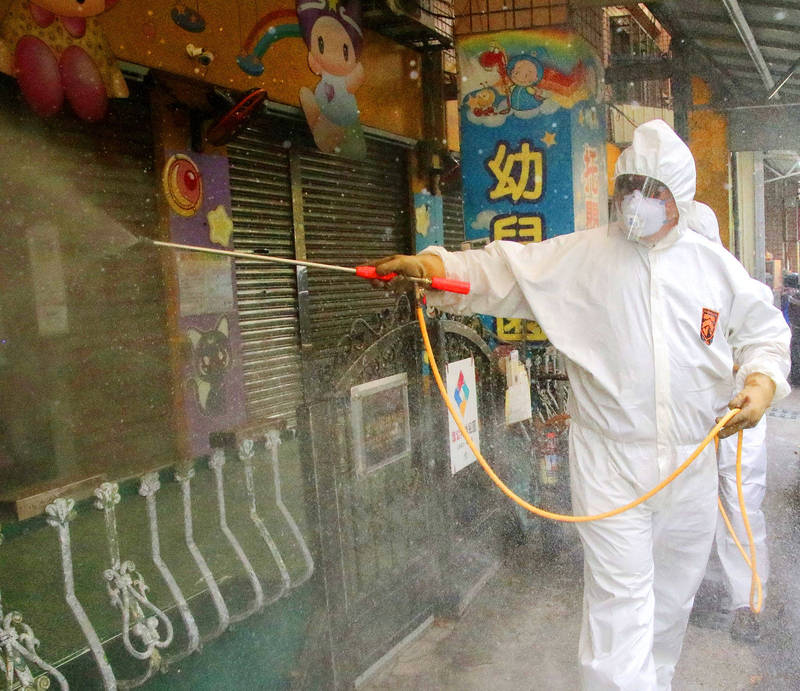《TAIPEI TIMES》 New rules to allow home quarantine in local cases

A Kaohsiung City Government employee sanitizes the outside of a kindergarten in Kaohsiung’s Fongshan District yesterday. Photo: CNA
By Jonathan Chin / Staff writer, with CNA
The Central Epidemic Command Center (CECC) yesterday released new guidelines that allow people with mild cases of COVID-19 to quarantine at home.
The announcement came after the CECC on Saturday last week said that more than 99 percent of local cases reported this year had mild or no symptoms.
Premier Su Tseng-chang (蘇貞昌) on Sunday announced the “new Taiwan mode” for fighting COVID-19.
The government should strike a balance between disease prevention and economic growth, Su said.
Philip Lo (羅一鈞), deputy head of the CECC’s medical response division, yesterday told the center’s daily news conference that people with COVID-19 can quarantine at home if they have mild or no symptoms, are younger than 65, are not pregnant and do not need to undergo dialysis.
Members of a household in which a person is quarantining must also meet the criteria, he added.
The quarantined person must stay in a separate room, while shared showers and toilets must be cleaned thoroughly after each use, he said.
The rules apply to all people listed as domestic cases, including those who tested positive after completing mandatory quarantine after arriving in Taiwan from abroad, he said.
Those listed as imported cases can quarantine at home if they live alone or quarantine together with another infected person in the same household, Lo said, adding that exceptions might be made for people with special care needs.
People living in the same household as a person quarantining at home should be tested three times — 10 days after the case’s initial diagnosis, as well as five and 10 days after the person began quarantining at home, he said.
People who live in a household with four or more others would not be allowed to quarantine at home, Lo added.
Cases can leave home quarantine if they test negative in a home test or a polymerase chain reaction test, he said.
People who test positive 10 or more days after their initial diagnosis may also leave home quarantine if their cycle threshold value is 30 or higher, they have not had a fever for 24 hours and their other symptoms are easing, Lo added.
Upon ending home quarantine, the infected person and anyone living with them must practice self-health management for seven days, with mandatory self-administered rapid tests on the third day and seventh day, he said.
Local governments have the responsibility to notify residents who qualify for home quarantine and monitor their compliance with the quarantine rules, he said.
The mobile phone-based “electronic fence” system would be used to monitor whether people leave their quarantine venue, he added.
Local governments must also work with the central government to establish COVID-19 care service centers, he said.
The centers would be equipped with home test kits for COVID-19 and blood oxygen tests, and offer remote medical consultations, transportation to and from hospitals, and other services, he added.
Household members of people quarantining at home must be ready to immediately seek medical care for the infected person should their condition deteriorate, he said.
When home-quarantined cases have difficulty breathing, chest pain, or their skin, lips or fingernails turn blue, household members should immediately call the 1922 hotline, he said.
新聞來源:TAIPEI TIMES















